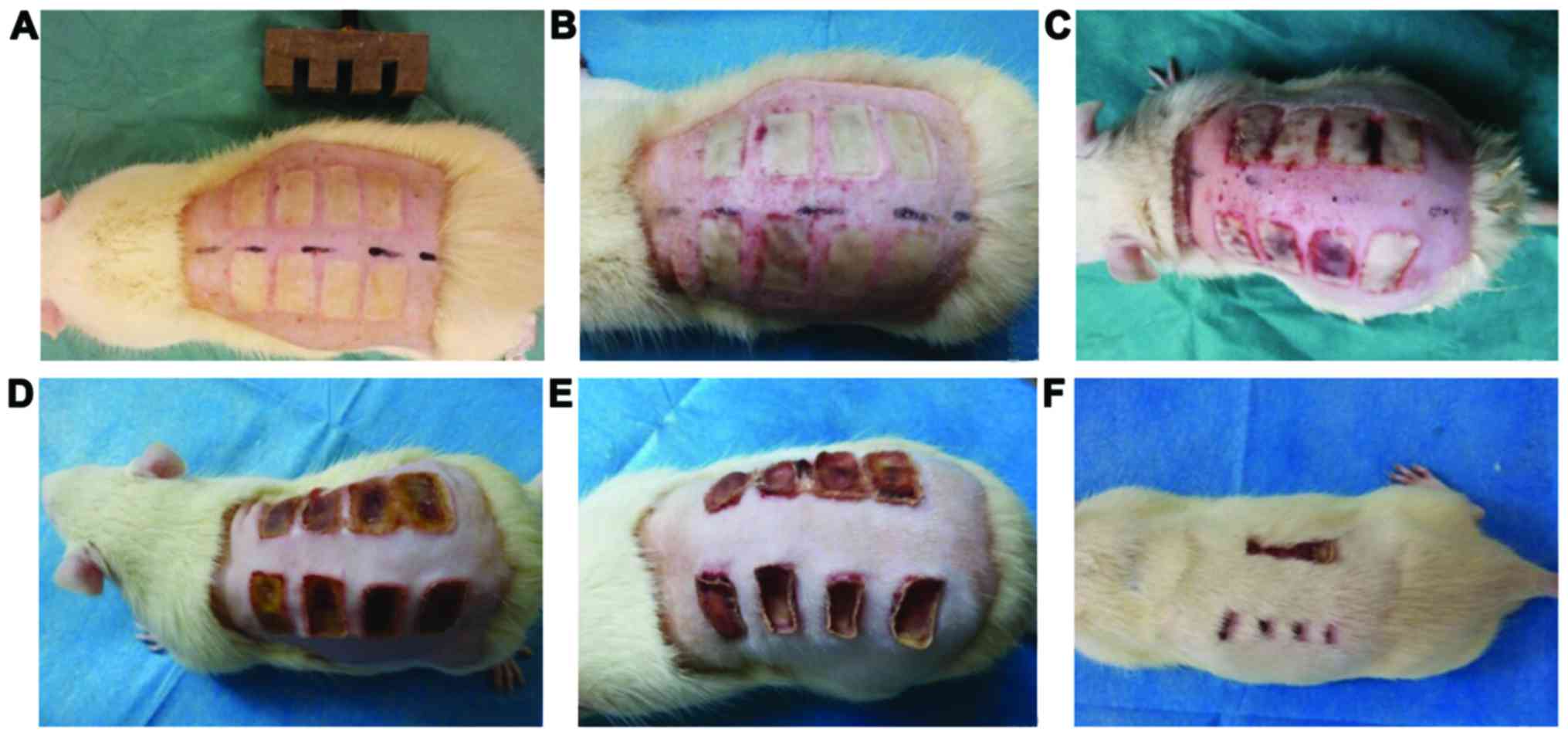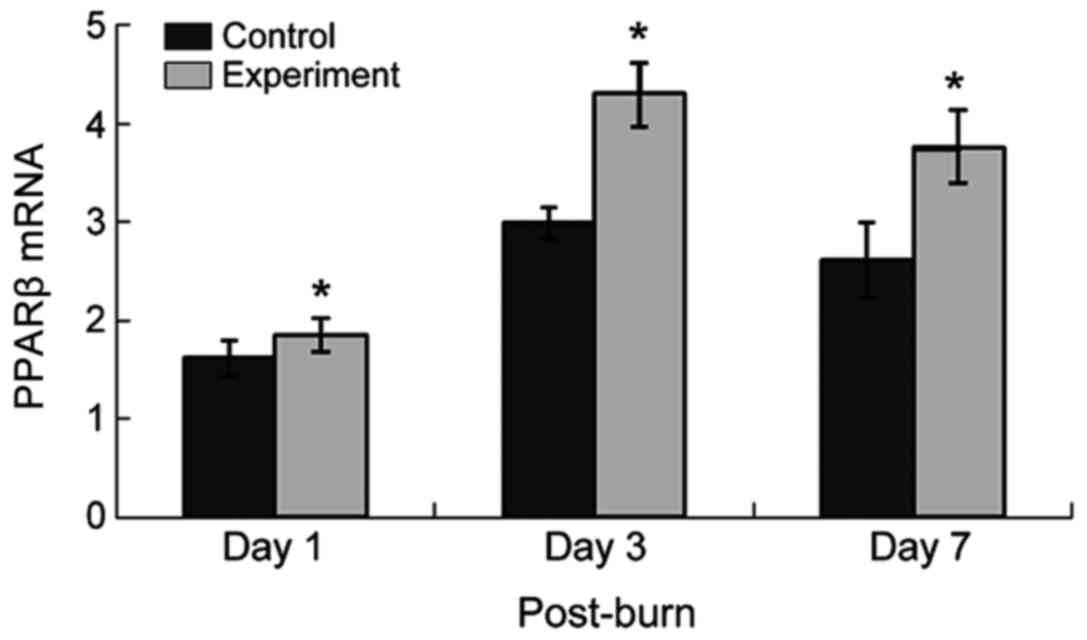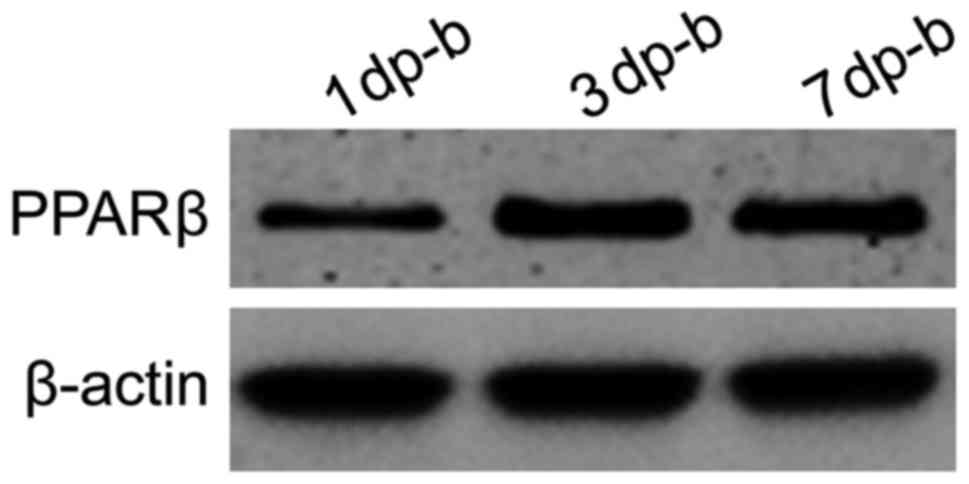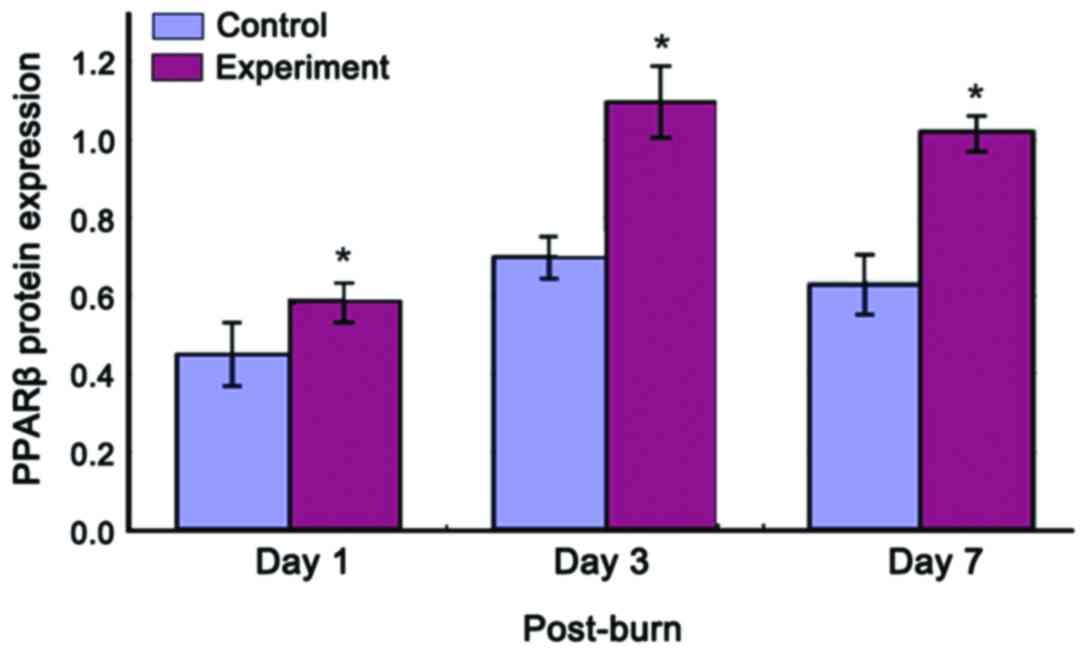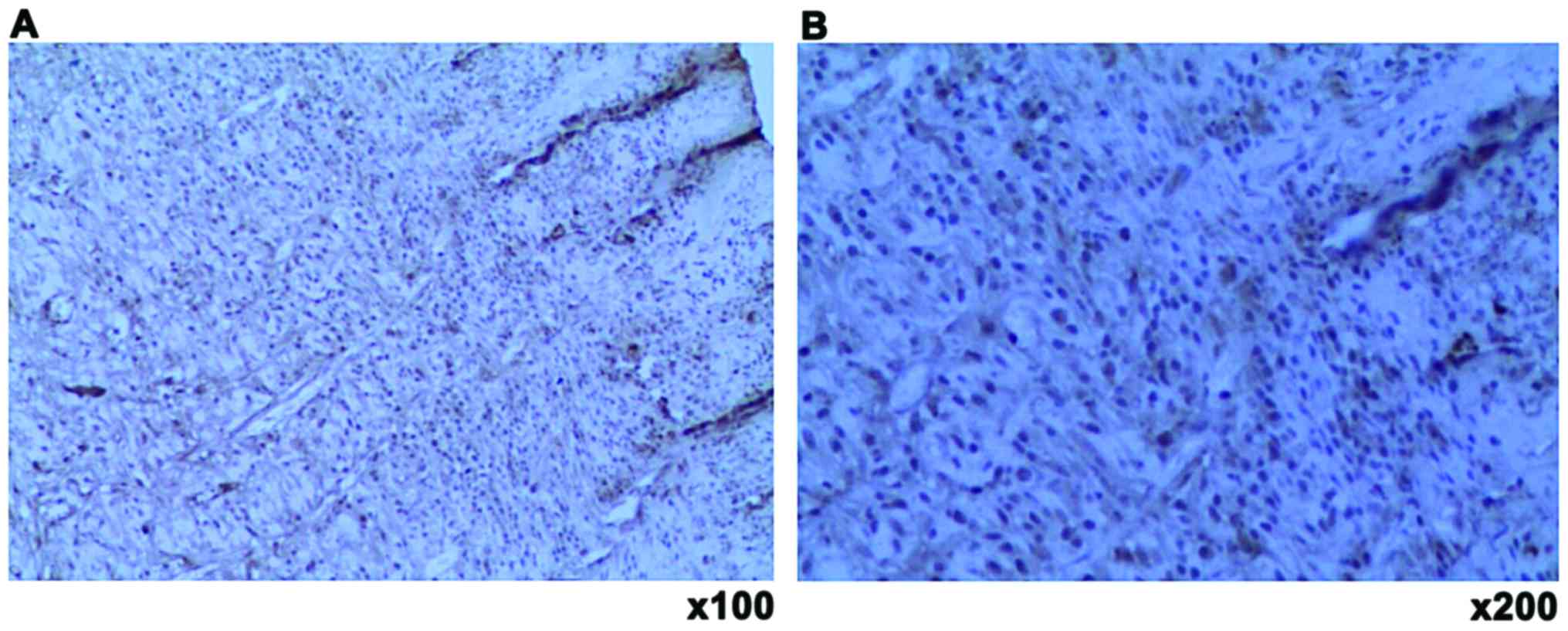Topically administered rhGM-CSF affects PPARβ expression in the stasis zone
- Authors:
- Published online on: September 20, 2017 https://doi.org/10.3892/etm.2017.5146
- Pages: 4825-4830
-
Copyright: © Fu et al. This is an open access article distributed under the terms of Creative Commons Attribution License.
Abstract
Introduction
Thermal injuries can involve microcirculation dysfunctions, inflammatory responses and edema in the heated skin, which can lead to ischemia-induced injury, cellular metabolic dysfunctions and even, ultimately, cell death (1–3). Jackson (4) described burn wounds in terms of three concentric zones based on clinical observations and histologic investigations. The central zone is the zone of coagulation that is irreversibly damaged by the heat; this zone is surrounded by a stasis zone, which is surrounded by a zone of hyperemia (2). The outermost hyperemia zone will fully recover. Within the first 48 and 72 h (or longer) following thermal injury, the stasis zone exhibits progressive necrosis, which accounts for the varying depth and extent of skin burns (5,6). Therefore, the optimal intervention at this stage involves the salvage of the stasis zone. Hence, the stasis zone has become a focus of burn research and treatment.
Peroxisome proliferator activated receptors (PPARs), including PPARα, PPARβ/δ and PPARγ, are transcription factors and members of the steroid nuclear hormone receptor superfamily. PPARs primarily exist in rodents, amphibians and humans (7). PPARβ/δ is one of three subtypes and plays a paramount roles in placentation, hepatic stellate cell proliferation, colon cancer occurrence, cholesterol transfer and lipid metabolism (8). The activation of PPARβ inhibits apoptosis, promotes cell proliferation and has clearly defined roles in burn wound healing (9).
Granulocyte-macrophage colony-stimulating factor (GM-CSF) is a cytokine that is capable of stimulating proliferation and differentiation into hematopoietic stem cells and the subsequent formation of granulocytes, macrophages and granulocyte-macrophage colonies. Previous studies have demonstrated that recombinant human granulocyte-macrophage colony-stimulating factor (rhGM-CSF) has a variety of functions, including the stimulation of bone marrow hematopoiesis and the induction of the differentiation of myofibroblasts (10).
Recent evidence suggests that topically applied rhGM-CSF gel facilitates wound contraction, mediates cell proliferation and differentiation, induces vascularization and promotes burn wound healing (11,12). The entire process of wound healing involves a complex interplay of different cell populations, growth factors, the extracellular matrix and cytokines.
PPARβ is also an important factor for promoting wound healing, and the present study was conducted to investigate the influence of the topical application of rhGM-CSF gel to thermally damaged skin on PPARβ gene expression in an animal scald model.
Materials and methods
Experimental protocol and reagents
Fifty adult male Sprague-Dawley rats weighing between 250 and 300 g were provided by the Experimental Animal Centre of Zhengzhou University for this study. All animals were fed rat chow and provided water ad libitum. The present study was approved by the Local Animal Care Committee.
The following reagents and equipment (with the suppliers indicated in the parentheses) were employed: 100 µg/10 g rhGM-CSF hydrogel and hydrogel without rhGM-CSF (both provided by GeneScience Pharmaceuticals Co., Ltd., Changchun, China); BCA protein quantitative kits (23225; Thermo Fisher Scientific, Waltham, MA, USA), sodium dodecyl sulfate polyacrylamide gel electrophoresis (SDS-PAGE) gel preparation kits (P0012A; Blue Skies Institute of Biotechnology), polyvinylidene fluoride (PVDF) membrane (aperture: 0.45 µM; GS0914; Millipore, Billerica, MA, USA), enhanced HRP-DAB chromogenic substrate kits (PA110; Tiangen Biotech Co., Ltd., Beijing, China), PPARβ antibodies (1:500; sc-74517; Santa Cruz Biotechnology, Santa Cruz, CA, USA), two resistance (7076; Cell Signaling Technology, Danvers, MA, USA), Bio-Rad protein3 electrophoresis apparatus, Bio-Rad transblotDianZhuan instrument, Bio-Rad ChemiDoc chemiluminescence imaging, TRIzol (15596–018; Invitrogen, Carlsbad, CA, USA), reverse transcription kit (K1622; Fermentas, Waltham, MA, USA), a quantitative qRT-PCR (SYBR-Green I) kit (FP302-02; Tiangen Biotech); a rabbit anti-goat ready-to-use two-gait detection kit and double-amino benzidine chromogenic reagent kit (Beijing Zhongshan Golden Bridge Biotechnology Co., Ltd., Beijing, China); optical microscope (Olympus, Tokyo, Japan); and a photographic microscope system (Leica Microsystems, Wetzlar, Germany).
Thermal injury and treatment
Adult male Sprague Dawley rats weighing 250–300 g (n=50) were used for the experimental protocol. Fifty rats were randomly divided into five groups (n=10 per group). The day before the trial, the back hair of all rats was removed with a sodium sulfide solution (80 g/l), and symmetric scald models were created in all five groups of rats on both sides of the dorsal spines. The scalded skin on the left sides of the five groups served as the experimental groups, and the right sides served as the control group. Before the experiment began, rats were anesthetized via an intraperitoneal injection of 35 mg/kg of chloral hydrate (10%).
The burn model was established using a brass comb with four prongs (1 × 2 cm) separated by three 5-mm notches, as described by Regas and Ehrlich (13). Thus, four patches of burned skin and three intervening spaces (0.5 × 2 cm) of unburned skin were created and served as the coagulation zones and the stasis zones, respectively.
These interspaces in the experimental and control groups were treated with 100 µg/10 g rhGM-CSF hydrogel and hydrogel without rhGM-CSF, respectively, once at 30 min after the burn and once daily thereafter. The gels were applied at a thickness of 1 mm and subsequently covered with a layer of vaseline and sterile gauze that was properly fixed with adhesive tape. The scald models on either side of the dorsal spines were symmetrically dressed including the stasis zones of 5 × 20 mm. The left side stasis zones served as the experimental group, and the right side stasis zones served as the control group.
Macroscopic analysis
In total, there were 300 stasis zones in both groups or 150 in each of the experimental and control groups. We observed the macroscopic changes in the organizations of the stasis zones at the experimental time-point of post-burn days 1, 3, 7, 14 and 21. The macroscopic assessments involved the assessment of the survival:necrosis ratios of the stasis zones (interspaces) of the experimental and control groups.
Tissue specimen collection and detection
Ten rats from both groups were taken on the 1st, 3rd, 7th,14th and 21st post-burn days. The stasis zones (interspaces) were exactly excised from the experimental and control groups following the application of chloral hydrate (10%) anesthesia. These specimens were stored at −80°C and then subjected to reverse transcription-polymerase chain reaction (RT-PCR) and western blot detection. The other stasis zones of the experimental group were exactly excised on the 3rd day, fixed in 4% paraformaldehyde for 24 h, embedded in paraffin blocks, and sliced into 4-micron sections for immunohistochemical detection. After the specimens were excised, all rats were sacrificed under general anesthesia.
PPARβ/δ mRNA expression test
RT-PCR analyses were used to examine PPARβ/δ mRNA expression in both groups according to the following procedure. Specimens were placed in a mortar and liquid nitrogen was added for grinding. Total RNA was extracted from the stasis zone tissues with TRIzol agent. Primer 3 software (Premier Biosoft, Palo Alto, CA, USA) was used to design the primers, which were as follows: PPRAβ/δ upstream primer, 5′-CCTTCTCCAAGCACATCTACAA-3′; downstream primer, 5′-TGATGAAGGGTGCGTTATGG-3′. Using a primer amplification procedure involving a total RNA template and PCR amplification for RT-PCR amplification, glyceraldehyde-3-phosphate dehydrogenase (GAPDH) was measured relative to an internal control. An ABI Prism 7300 instrument with SDS software (Thermo Fisher Scientific, Waltham, MA, USA) was used for data analysis. The ΔΔct method was used to calculate the expression of genes and the efficiency of silencing.
PPARβ/δ protein expression detection
The specifications of the BCA working liquid and the applied liquid protein of the cracking crack cells were collected to determine the protein levels with the BCA method. Protein samples were readily placed at −20°C. Twenty grams of protein per lane were set aside and 60-V runs were performed with enrichment glue following polypropylene acyl amine gel electrophoresis. The transfer of the protein from a gel to a PVDF membrane was performed. PPARβ was closed over a long body of resistance after the PVDF membrane was treated with skimmed milk powder incubated at 4°C overnight. Horseradish peroxidase (HRP)-labeled sheep anti-rabbit IgG antibodies (1:2,000; sc-2004; Santa Cruz Biotechnology, Inc., Santa Cruz, CA, USA) were then added and the membrane was incubated for 40 min. A Bio-Rad chemiluminescence imager was used for development. Analysis of the grey values was conducted with ImageJ software (National Institutes of Health, Bethesda, MD, USA) and the grayscale coefficient ratio was then calculated.
Statistical analysis
The data are expressed as the means and standard deviations. The data from the control and the experimental groups were analyzed using independent sample t-tests with the SPSS 17.0 statistical software (SPSS Inc., Chicago, IL, USA). P<0.05 were regarded as statistically significant.
Results
Macroscopic assessment
On the 21st post-burn day, 87% of the stasis zone was viable in the rhGM-CSF treatment group, and 14% of the stasis zone was viable in the control group as shown in Fig. 1.
PPARβ mRNA expression
PPARβ expression increased on the 1st postburn day in the stasis zones of both groups, peaked 3 days after thermal injury, and subsequently decreased but remained elevated. In the experimental group, PPARβ expression at every phase was increased compared with the control group. Dry scabs had formed in some stasis zones of the control group one week after the injury, as shown in Fig. 2.
PPARβ protein expression and localization
PPARβ protein expression increased in both groups and then decreased following thermal injury. In the experimental group, the protein expression increased beyond that of the control group on the 1st post-burn day. The expression level peaked on the 3rd post-burn day and then gradually decreased, but the experimental group still exhibited a high level of expression on the 1st post-burn day (Figs. 3 and 4). PPARβ protein expression was mainly localized to the nuclei of the fibroblasts, keratinocytes and endothelial cells in the stasis zones of both groups (Fig. 5).
Discussion
After cutaneous thermal injury, the stasis zone may become necrotic and exhibit hypoperfusion, capillary vasoconstriction, edema and ischemia, which contribute to the progression of the overall burn extent or depth (1,14). During this pathological process, some cytokines and growth factors, including GM-CSF, other colony-stimulating factors and interleukins, are synthesized and released by monocytes, macrophages, keratinocytes, fibroblasts and neutrophils. These factors can cause further inflammatory injuries but can also regulate and promote keratinocyte, fibroblast and endothelial cell proliferation and differentiation in thermally damage tissue, which provide favorable conditions for preventing the formation of progressive damage in the interspaces (11,12,14). Because of these protective factors, the stasis zone has the characteristic of reversibility. To be precise, there are damage and protection factors that exist in burn wounds that limit pathophysiological changes. In experimental studies and clinical treatment, we attempt to adopt appropriate measures to maximize the protective factors and minimize the damaging factors to prevent progressive necrosis in the stasis zone.
As a type of specific glycoprotein, rhGM-CSF has a variety of functions, such as boosting vaccine immunogenicity and counteracting the bone marrow suppression caused by radiotherapy, chemotherapy, stem cell transplantation and severe infections (15). In recent years, research has demonstrated that GM-CSF is synthesized and secreted by activated neutrophils, monocytes/macrophages, keratinocytes, endothelial cells, and fibroblasts and enhances keratinocyte, endothelial cell and fibroblast migration and proliferation for wound healing (16,17). Infection and excessive local inflammation responses are often present in burn wounds (11). rhGM-CSF effectively improves wound bacterial clearance rates, increases neutrophil surface adhesion molecule expression, enhances neutrophil chemotaxis, reduces burn wound infection rates and prevents necrobiosis in burn wounds to a certain extent (18–20). Additionally, rhGM-CSF attracts inflammatory cells, modulates inflammatory responses, and prevents cascade reactions in burn wounds (11,15,20). In the process of wound healing, neovascularization may provide oxygen and nutrients for the inflammatory response and induce keratinocytes, endothelial cells, and macrophages to secrete endogenous growth factors that are involved in wound healing (21). Studies have demonstrated that rhGM-CSF induces microvascular endothelial cell proliferation, differentiation, and increased expression of the growth factors vascular endothelial growth factor (VEGF) and transforming growth factor (TGF)-1β. rhGM-CSF also promotes the vascularization of the wound (12). CD31 is activated in vascular endothelial cells that express the characteristic symbol. Liu et al (20) proposed that rhGM-CSF induces CD31 expression in new blood vessel endothelial cell surfaces, which further demonstrates that rhGM-CSF has a positive effect on the promotion of angiogenesis. However, the exact mechanism by which rhGM-CSF influences keratinocytes, fibroblasts and endothelial cells in burn wound repair are uncharacterized.
PPARs are important repair genes following thermal damage and are activated by lipid ligands that bind with PPAR response elements (PPREs) at loci that are members of the retinoid X receptor (RXR) family of the steroid hormone receptor superfamily and act as regulators of transcription. The application of GW0742 (a PPARβ activator) to heat injury-induced fibroblasts significantly increases PPARβ expression, which subsequently induces a protective effect by minimizing structural damage and increasing the cell proliferation response (22). In burn wounds, the activation of PPARβ inhibits apoptosis, stimulates the proliferation of keratinocytes, and induces angiogenesis and these processes are involved in the wound response and healing (23–25). On the one hand, post-traumatic skin inflammation activates PPARβ expression. On the other hand, this inflammatory factor also triggers the production of endogenous PPARβ ligands, ultimately inhibits cell apoptosis and induces keratinocyte proliferation and angiogenesis. These processes are involved in the wound response and the healing of the skin (24–26). This mechanism may increase PPARβ activity in these cells and subsequently upregulate the expression of integrin-linked kinase and 3-phosphoinositide-dependent kinase-1, which phosphorylates protein kinase B-α (Akt1) (26,27). Akt1 is a major downstream effector of phosphoinositide 3-kinase signaling. The resulting increased Akt1 activity suppresses apoptosis and increases the likelihood of a sufficient number of viable keratinocytes being present in the wound margin for re-epithelialization and also increases matrix metalloproteinase-9 production by potentiating nuclear factor-κB activity, which regulates keratinocyte migration. Additionally, the activation of PPARβ also reduces the oxidative stress caused by cell apoptosis. The mechanism of this process involves the induction of alpha 14-3-3 protein, which has anti-apoptotic and anti-inflammatory effects that promote apoptotic protein degradation and that limit the promotion of apoptosis due to the caspase cascade (24,28). Furthermore, activated PPARβ promotes the proliferation of human and murine vascular endothelial cells in vitro by increasing VEGFR1 (Flt-1) expression and VEGF production (25,29).
The ‘comb burn’ model has been previously validated and is widely used in investigations of the stasis zone. Previous studies have examined the applications of antithrombotic, anticoagulant, antioxidant and anti-inflammatory agents in experimental models individually, and these agents exhibit beneficial effects in terms of salvaging the stasis zone (3,5,6). Although tissues and cells secrete small amounts of cytokines and growth factors after thermal damage, the thermal effects of and pathological changes in these factors still cause anoxic tissue ischemia conditions. Endogenous growth factors are often not sufficient to continually stimulate and effectively initiate the thermal damage repair procedure (30). After consulting relevant literature, we chose the dressing scald model and applied external rhGM-CSF to the thermally damaged skin. The survival rate in the experimental group was significantly increased compared with the control group, and PPARβ was expressed at a higher level in the experimental group compared with the control group. Moreover, PPARβ expression was mainly localized to the fibroblasts/endothelial cells and the cuticular cell nuclei. rhGM-CSF may activate or regulate PPARβ expression through a specific pathway early after thermal damage and prevent the stasis zone from exhibiting further irreversible necrosis. We hypothesize that PPARβ may play an important role in this process.
Necrobiosis of the stasis zone was associated with multiple factors. Thermal injury, ischemic reperfusion, inflammatory reactions and oxidative free radical damage were among the factors that were closely related to and promoted each other. In the present study, we used an animal comb thermal model and found that rhGM-CSF could preliminarily upregulate PPARβ gene and protein expression via various pathways. In addition, rhGM-CSF had a certain protective effect on the stasis zone. However, single intervention factors obviously have certain limitations. We also observed that not the entire stasis zone could be kept alive. Therefore, in the process of deep burn treatment, the mechanisms by which comprehensive interventions focused on the above factors improve the local environment, prevent secondary injury and promote benign outcomes in the stasis zone represent difficulties that are still faced by medical workers dealing with burns.
References
|
Keck M, Herndon DH, Kamolz LP, Frey M and Jeschke MG: Pathophysiology of burns. Wien Med Wochenschr. 159:327–336. 2009. View Article : Google Scholar : PubMed/NCBI | |
|
Goertz O, Vogelpohl J, Jettkant B, Daigeler A, Steinau HU, Steinstraesser L and Langer S: Burn model for in vivo investigations of microcirculatory changes. Eplasty. 9:e132009.PubMed/NCBI | |
|
Nisanci M, Eski M, Sahin I, Ilgan S and Isik S: Saving the zone of stasis in burns with activated protein C: An experimental study in rats. Burns. 36:397–402. 2010. View Article : Google Scholar : PubMed/NCBI | |
|
Jackson DM: The diagnosis of the depth of burning. Br J Surg. 40:588–596. 1953. View Article : Google Scholar : PubMed/NCBI | |
|
Zor F, Ozturk S, Deveci M, Karacalioglu O and Sengezer M: Saving the zone of stasis: Is glutathione effective? Burns. 31:972–976. 2005. View Article : Google Scholar : PubMed/NCBI | |
|
Eski M, Ozer F, Firat C, Alhan D, Arslan N, Senturk T and Işik S: Cerium nitrate treatment prevents progressive tissue necrosis in the zone of stasis following burn. Burns. 38:283–289. 2012. View Article : Google Scholar : PubMed/NCBI | |
|
Noratto G, Martino HS, Simbo S, Byrne D and Mertens-Talcott SU: Consumption of polyphenol-rich peach and plum juice prevents risk factors for obesity-related metabolic disorders and cardiovascular disease in Zucker rats. J Nutr Biochem. 26:633–641. 2015. View Article : Google Scholar : PubMed/NCBI | |
|
Wagner KD and Wagner N: Peroxisome proliferator-activated receptor beta/delta (PPARbeta/delta) acts as regulator of metabolism linked to multiple cellular functions. Pharmacol Ther. 125:423–435. 2010. View Article : Google Scholar : PubMed/NCBI | |
|
Yao PL, Chen L, Dobrzański TP, Zhu B, Kang BH, Müller R, Gonzalez FJ and Peters JM: Peroxisome proliferator-activated receptor-β/δ inhibits human neuroblastoma cell tumorigenesis by inducing p53- and SOX2-mediated cell differentiation. Mol Carcinog. 56:1472–1483. 2017. View Article : Google Scholar : PubMed/NCBI | |
|
Akay R, Kamisli O, Kahraman A, Oner S and Tecellioglu M: Evaluation of aqueductal CSF flow dynamics with phase contrast cine MR imaging in idiopathic intracranial hypertension patients: Preliminary results. Eur Rev Med Pharmacol Sci. 19:3475–3479. 2015.PubMed/NCBI | |
|
Yan H, Chen J and Peng X: Recombinant human granulocyte-macrophage colony-stimulating factor hydrogel promotes healing of deep partial thickness burn wounds. Burns. 38:877–881. 2012. View Article : Google Scholar : PubMed/NCBI | |
|
Rho CR, Park MY and Kang S: Effects of granulocyte-macrophage colony-stimulating (GM-CSF) factor on corneal epithelial cells in corneal wound healing model. PLoS One. 10:e01380202015. View Article : Google Scholar : PubMed/NCBI | |
|
Regas FC and Ehrlich HP: Elucidating the vascular response to burns with a new rat model. J Trauma. 32:557–563. 1992. View Article : Google Scholar : PubMed/NCBI | |
|
Singer AJ, McClain SA, Taira BR, Guerriero JL and Zong W: Apoptosis and necrosis in the ischemic zone adjacent to third degree burns. Acad Emerg Med. 15:549–554. 2008. View Article : Google Scholar : PubMed/NCBI | |
|
Yuan L, Minghua C, Feifei D, Runxiu W, Ziqiang L, Chengyue M and Wenbo J: Study of the use of recombinant human granulocyte-macrophage colony-stimulating factor hydrogel externally to treat residual wounds of extensive deep partial-thickness burn. Burns. 41:1086–1091. 2015. View Article : Google Scholar : PubMed/NCBI | |
|
Smith CH, Allen MH, Groves RW and Barker JN: Effect of granulocyte macrophage-colony stimulating factor on Langerhans cells in normal and healthy atopic subjects. Br J Dermatol. 139:239–246. 1998. View Article : Google Scholar : PubMed/NCBI | |
|
Da Costa RM, Jesus Ribeiro FM, Aniceto C and Mendes M: Randomized, double-blind, placebo-controlled, dose-ranging study of granulocyte-macrophage colony stimulating factor in patients with chronic venous leg ulcers. Wound Repair Regen. 7:17–25. 1999. View Article : Google Scholar : PubMed/NCBI | |
|
Zhang L, Chen J and Han C: A multicenter clinical trial of recombinant human GM-CSF hydrogel for the treatment of deep second-degree burns. Wound Repair Regen. 17:685–689. 2009. View Article : Google Scholar : PubMed/NCBI | |
|
Kobayashi SD, Braughton KR, Whitney AR, Voyich JM, Schwan TG, Musser JM and DeLeo FR: Bacterial pathogens modulate an apoptosis differentiation program in human neutrophils. Proc Natl Acad Sci USA. 100:10948–10953. 2003. View Article : Google Scholar : PubMed/NCBI | |
|
Liu JS, Fang Y, Yao M, Yu WR and Du J: Effects of rhGM-CSF on scalding wound healing and neovascularization in rats. J Bengbu Med Coll. 37:17–19. 2012. | |
|
Seegers HC, Hood VC, Kidd BL, Cruwys SC and Walsh DA: Enhancement of angiogenesis by endogenous substance P release and neurokinin-1 receptors during neurogenic inflammation. J Pharmacol Exp Ther. 306:8–12. 2003. View Article : Google Scholar : PubMed/NCBI | |
|
Zuo C, Liang P and Huang X: Role of PPARbeta in fibroblast response to heat injury. Indian J Biochem Biophys. 49:219–227. 2012.PubMed/NCBI | |
|
Tyagi S, Gupta P, Saini AS, Kaushal C and Sharma S: The peroxisome proliferator-activated receptor: A family of nuclear receptors role in various diseases. J Adv Pharm Technol Res. 2:236–240. 2011. View Article : Google Scholar : PubMed/NCBI | |
|
Di-Poï N, Michalik L, Tan NS, Desvergne B and Wahli W: The anti-apoptotic role of PPARbeta contributes to efficient skin wound healing. J Steroid Biochem Mol Biol. 85:257–265. 2003. View Article : Google Scholar : PubMed/NCBI | |
|
Piqueras L, Reynolds AR, Hodivala-Dilke KM, Alfranca A, Redondo JM, Hatae T, Tanabe T, Warner TD and Bishop-Bailey D: Activation of PPARbeta/delta induces endothelial cell proliferation and angiogenesis. Arterioscler Thromb Vasc Biol. 27:63–69. 2007. View Article : Google Scholar : PubMed/NCBI | |
|
Attianese Giordano GM and Desvergne B: Integrative and systemic approaches for evaluating PPARβ/δ (PPARD) function. Nucl Recept Signal. 13:e0012015.PubMed/NCBI | |
|
Di-Poï N, Tan NS, Michalik L, Wahli W and Desvergne B: Antiapoptotic role of PPARbeta in keratinocytes via transcriptional control of the Akt1 signaling pathway. Mol Cell. 10:721–733. 2002. View Article : Google Scholar : PubMed/NCBI | |
|
Liou JY, Lee S, Ghelani D, Matijevic-Aleksic N and Wu KK: Protection of endothelial survival by peroxisome proliferator-activated receptor-delta mediated 14-3-3 upregulation. Arterioscler Thromb Vasc Biol. 26:1481–1487. 2006. View Article : Google Scholar : PubMed/NCBI | |
|
Bishop-Bailey D: PPARs and angiogenesis. Biochem Soc Trans. 39:1601–1605. 2011. View Article : Google Scholar : PubMed/NCBI | |
|
Gravante G, Palmieri MB, Esposito G, Delogu D, Santeusanio G, Filingeri V and Montone A: Apoptotic cells are present in ischemic zones of deep partial-thickness burns. J Burn Care Res. 27:688–693. 2006. View Article : Google Scholar : PubMed/NCBI |



